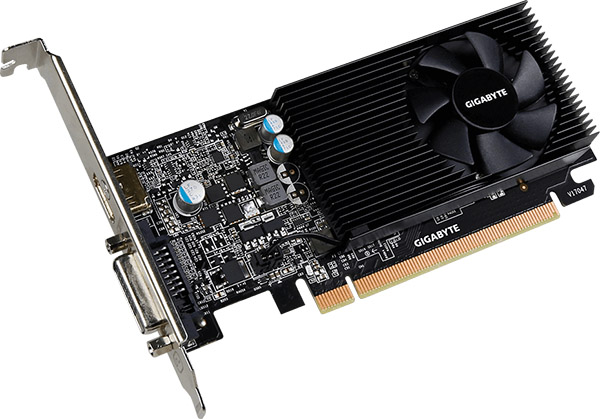Nvidia GeForce GT 1030 2GB Review
Why you can trust Tom's Hardware
Conclusion
Given the GeForce GT 1030’s resource deficit compared to Radeon RX 550, Nvidia fares remarkably well with GP108. In older DirectX 9- and 11-based games, it’s typically faster, while newer DirectX 12- and graphics-bound Vulkan-based workloads like Doom favor AMD’s GCN architecture. Dota 2 under Vulkan is a special case in that our Core i3-6320 seems to get in the way, and in platform-bottlenecked situations, GeForce cards do tend to fare better than Radeons.
We can’t help but think that this is the inverse of what you’d want from GeForce GT 1030, though. The older titles we tested already run at higher frame rates, facilitating better-looking detail settings before they start slowing down. Meanwhile, it’s all we can do to get Battlefield 1 and Doom smooth at their lowest quality presets at 1920x1080. It’d be great if performance were better in those situations, rather than the games averaging 100 FPS+.
Nvidia counters that gamers spending $70 on a graphics card play titles like League of Legends, Dota, and Rocket League, though, not Battlefield. We don’t doubt the company is right. After all, those are the same names AMD was going after when it briefed us on Radeon RX 550. In the context of DirectX 9/11-based software, games bound by platform performance, and popular eSports titles, then, GeForce GT 1030 is faster than Radeon RX 550. It's also less expensive and a lot more power-friendly.
Still, we’d like the option to experiment with any game on the PC. If you plan on playing newer DirectX 12 titles, the advantage we’ve seen from AMD’s faster cards carries over to the entry-level space. Its Radeon RX 550 averages more than 60 FPS in Battlefield 1 at 1920x1080 on a Core i3-based system. Even if it means tolerating the Low quality preset, at least the experience is fairly smooth. GeForce GT 1030 musters about 80% of the Radeon's performance in that situation.
Of course, we're assuming that your machine can accommodate the Radeon. The 4GB Asus RX 550 we tested occupies a full-height, dual-slot form factor. Meanwhile Gigabyte’s GeForce GT 1030 Low Profile 2G only monopolizes one slot. A bundled half-height bracket quickly adapts the card for the smallest of enclosures. In short, if your PC has an open PCIe slot, this GT 1030 should fit (and we’ve seen some highly non-standard case designs from the likes of Dell, HP, etc.). We’re sure the HTPC crowd will appreciate this flexibility (in addition to HDMI 2.0b support and eighth-gen PureVideo decoding hardware).
So back to the question we posed at the outset of our review: does GeForce GT 1030 keep up in our benchmark suite, at least enough to earn a position in Best Gaming Graphics Cards? Given that our opening category is Best eSports & HD, and in light of the GT 1030’s excellent handling of those titles at a 30% discount compared to RX 460, yeah, a recommendation is warranted. Just be aware that there is a point where the Radeon starts pulling ahead in a profound way. At that point, though, you might want to consider a Radeon RX 560 or 570 instead to enjoy more taxing DX12 games at higher quality settings.
MORE: Best Graphics Cards
Get Tom's Hardware's best news and in-depth reviews, straight to your inbox.
MORE: Desktop GPU Performance Hierarchy Table
MORE: All Graphics Content
-
turkey3_scratch This is a fantastic chip! Seeing as it performs nearly on-par with the 750Ti, it has approximately double the performance/power ratio. It is also perfect for a noiseless PC, the passively cooled one is.Reply -
takeshi7 Does this card work with 4K Netflix? From what I've read Nvidia requires 3GB VRAM for it which seems stupid and arbitrary. 2GB is enough to buffer several seconds of 4K movie frames.Reply -
King_V Definitely interesting. Going through the initial tests, I actually started wondering why the RX550 was lower in the hierarchy charts than the 750Ti.Reply
Then, when they switched positions in some other tests, it became more clear. And, I concluded that even putting certain cards in tiers relative to each other is not that easy.
I was very glad to see this test, though, as I'd previously considered getting the GT1030. My need for it is no longer there.
Overall, I think the 750Ti, RX 550, and RX 460 are closer to each other than I anticipated. It does seem the 1030 is behind them all, but not too far behind.
Thanks for this review. I can't wait to see where it ultimately falls in the hierarchy chart(which, oddly, is missing the RX 560 but I suspect that is in the same tier as the RX 460) -
hendriksnyder Will this work with a core I7 7700k? And would it be able to run games like FO4 and TitanFall 2 on ultra settings?Reply -
takeshi7 Reply19934708 said:TAKESHI7
yes it's enough, IDK where you heard that you need 3gb or VRAM.
Multiple sources say you need 3GB VRAM
http://nvidia.custhelp.com/app/answers/detail/a_id/4457/~/preview-of-4k-uhd-netflix-content-on-nvidia-gpus
http://www.pcworld.com/article/3193566/components-graphics/nvidia-quietly-opens-4k-netflix-streaming-on-geforce-gtx-10-series-graphics-cards.html
It's pretty stupid because that means you have to spend twice as much to get a 1050 Ti minimum.
-
zcat Can't wait to swap out my miniITX's old 750Ti with a true successor that's twice as powerful at the same bus-powered max of 60W.Reply -
mikegrok I am going to be installing a bunch of these into a dental office as soon as stocks get better. Dental offices have 2 monitors per computer (usually using the gti 720). One for work, and one to show Netflix, and distract the patients. The computers have CPUs that don't accelerate h265, and the 1000 series nvidia GPUs accelerate the current video codecs.Reply

